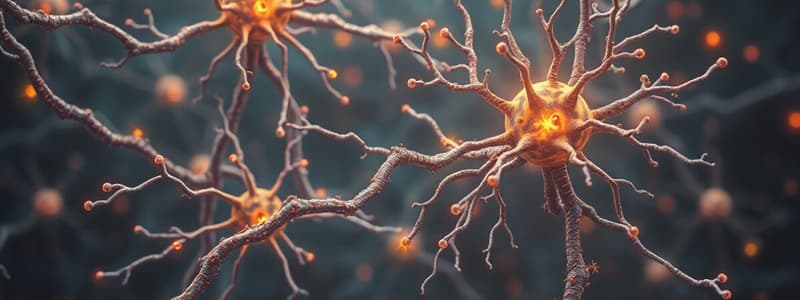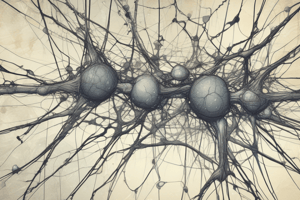Podcast
Questions and Answers
How would damage to the myelin sheath affect neuronal communication?
How would damage to the myelin sheath affect neuronal communication?
- It would enhance neurotransmitter release at the synapse.
- It would slow down or disrupt the transmission of action potentials. (correct)
- It would have no effect on the speed of action potential transmission.
- It would increase the speed of action potential transmission.
What primary role do interneurons play within the central nervous system?
What primary role do interneurons play within the central nervous system?
- Transmitting sensory information directly to muscles.
- Facilitating communication between sensory and motor neurons. (correct)
- Producing cerebrospinal fluid.
- Protecting the brain from physical trauma.
What is the primary function of the blood-brain barrier?
What is the primary function of the blood-brain barrier?
- To prevent harmful substances in the blood from entering the central nervous system. (correct)
- To supply the brain with unlimited nutrients.
- To circulate cerebrospinal fluid.
- To filter the blood for harmful toxins.
Which of these is NOT a component of a neuron?
Which of these is NOT a component of a neuron?
Where does communication primarily occur between two neurons?
Where does communication primarily occur between two neurons?
Flashcards
What are neurons?
What are neurons?
Specialized cells that transmit information throughout the body.
Dendrites, cell body, axon, axon terminals functions?
Dendrites, cell body, axon, axon terminals functions?
Receive signals, contain the nucleus, transmit signals, and release neurotransmitters respectively.
What is myelin sheath?
What is myelin sheath?
Insulates the axon, speeding up signal transmission.
What are sensory neurons?
What are sensory neurons?
Signup and view all the flashcards
Function of Meninges?
Function of Meninges?
Signup and view all the flashcards
Study Notes
Neurons and Neural Communication
- Neurons are specialized cells that carry information throughout the body.
- Key parts of a neuron include dendrites, cell body, axon, and axon terminals.
- Myelin sheath insulates axons, improving signal transmission speed and efficiency.
- Information is transmitted via action potentials, which involve the exchange of sodium and potassium ions across the neuron's membrane.
- Communication between neurons occurs at synapses through the release of neurotransmitters like acetylcholine.
Types of Neurons
- Sensory neurons carry information from sensory receptors to the brain, enabling perception and awareness.
- Motor neurons transmit signals from the brain to muscles, initiating and controlling movement.
- Interneurons connect sensory and motor neurons within the central nervous system (CNS), facilitating complex reflexes and neural circuits.
Protection of the CNS
- The skull and vertebrae provide bony protection to the brain and spinal cord, safeguarding them from physical trauma.
- The meninges consist of three layers: dura mater, arachnoid mater, and pia mater, which further protect the CNS.
- Cerebrospinal fluid circulates around the brain and spinal cord, providing cushioning and nutrient transport.
- The blood-brain barrier prevents harmful substances from entering the CNS, maintaining a stable environment for neural function.
Cranial Nerves
- This section lists six important cranial nerves.
Studying That Suits You
Use AI to generate personalized quizzes and flashcards to suit your learning preferences.




